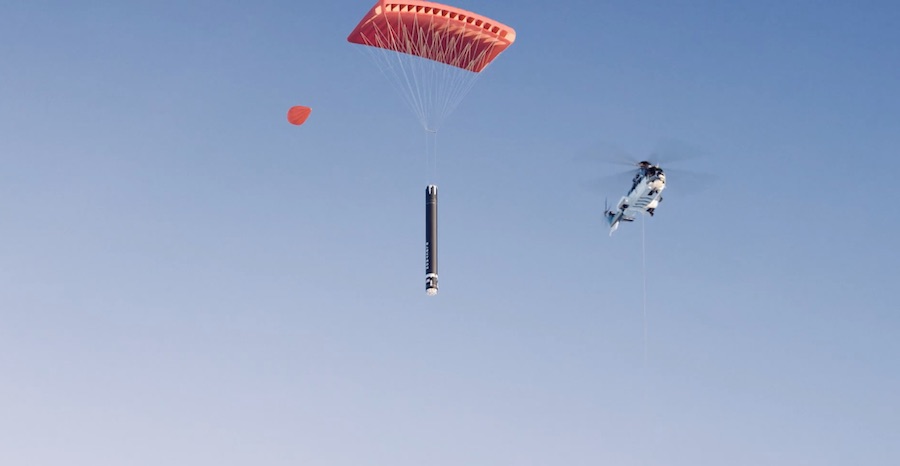
Rocket Lab said this week that its next mission, set for launch Nov. 10 after delays caused by a coronavirus lockdown in New Zealand, will include the company’s third booster recovery experiment. For the first time, Rocket Lab plans to have a helicopter in the downrange recovery zone to observe the descending booster in preparation for future mid-air catch attempts.
The helicopter and a recovery boat will be positioned around 230 miles (370 kilometers) southeast of Rocket Lab’s launch site at Mahia Peninsula on New Zealand’s North Island.
Rocket Lab’s booster recovery experiments are intended to fine-tune the company’s concept for retrieving and reusing rockets. Peter Beck, the company’s founder and CEO, says reusing Electron boosters will allow Rocket Lab to increase its launch cadence and cut costs.
The Electron rocket’s kerosene-fueled first stage will shut down and separate from the rocket’s second stage about two-and-a-half minutes after liftoff, coast to the high point of its trajectory, then descend back into the atmosphere. A thermal shield will protect the 4-foot-wide (1.2-meter) booster until a parachute deploys, slowing its fall into the Pacific Ocean.
On future missions, Rocket Lab will try to snag the parachute and rocket stage in mid-air using a helicopter. The company has retrieved two rockets from the Pacific Ocean on two previous recovery attempts in November 2020 and May of this year.
Rocket Lab said teams will test communications and tracking on the next recovery attempt, practicing for a helicopter catch on a later flight.
“It’s time to bring in the helicopter for the real thing,” Beck tweeted Tuesday. “This mission will simulate the catch and will be the last test before we will pluck one out of the sky after returning it from space.”
Launch of Rocket Lab’s 22nd Electron mission is scheduled for a window opening at 11:25 p.m. EST on Nov. 10 (0425 GMT on Nov. 11). The privately-developed rocket and its kick stage will deploy two small commercial BlackSky Earth-imaging satellites into a mid-inclination, 267-mile-high (430-kilometer) orbit.
“As one of only two companies to recover an orbital-class booster from space, we’ve proven it’s possible to make Electron the world’s first orbital-class reusable small launch vehicle,” Beck said in a statement. “We’ve perfected Electron’s controlled descent, demonstrated flawless parachute deployment, and successfully plucked stages from the ocean. Now we’re gearing up for the next stage — preparing to use a helicopter to catch a rocket as it descends to Earth from space.”
Rocket Lab said the rocket on the next mission will debut an advanced parachute to deploy at a higher altitude, allowing the booster to make a slower descent into the Pacific Ocean. There are also upgrades to the heat shield to protect the rocket’s nine main engines from temperatures up to 4,000 degrees Fahrenheit (2,200 degrees Celsius).

“It’s ambitious, but with each recovery mission we’ve iterated and refined the hardware and processes to make the impossible ordinary,” Beck said. “I’m excited to take what we learn from this launch and put it into practice with aerial capture missions in future.”
Rocket Lab’s Electron launcher is sized to deliver small satellites to orbit, providing a dedicated ride for spacecraft that would otherwise have to fly as a lower-priority payload on a larger launch vehicle.
The Electron rocket has about 1% of the lift capability of a SpaceX Falcon 9 launcher, the only partially reusable rocket currently operational. Rocket Lab, which sells dedicated Electron missions for as little as $7 million, aims to join SpaceX on that short list.
The mission Nov. 10 is the first of three Rocket Lab flights in a row for BlackSky, each carrying a pair of remote sensing satellites. The next launch is scheduled for a window opening Nov. 27.
BlackSky, with offices in Seattle and Herndon, Virginia, is deploying a fleet of small remote sensing satellites to provide high-resolution Earth imagery to commercial and government clients. One big potential customer for BlackSky is the U.S. military and intelligence agencies.
BlackSky’s satellites are built by LeoStella, a joint venture between Spaceflight Industries and Thales Alenia Space, a major European satellite manufacturer. LeoStella’s production facility is located in Tukwila, Washington, a suburb of Seattle.
Rocket Lab and BlackSky announced an agreement earlier this year for five Electron launches to carry nine BlackSky satellites into orbit.
The first launch in the multi-mission contract successfully deployed a single BlackSky payload into orbit in March. The second of the five missions in May failed before reaching orbit due to a malfunction in the Electron rocket’s second stage. The two BlackSky satellites on-board crashed back to Earth.
The next three missions will complete the five-launch agreement between Rocket Lab and BlackSky. Spaceflight, a Seattle-based rideshare company, brokered the launch agreement for BlackSky.
Email the author.
Follow Stephen Clark on Twitter: @StephenClark1.
